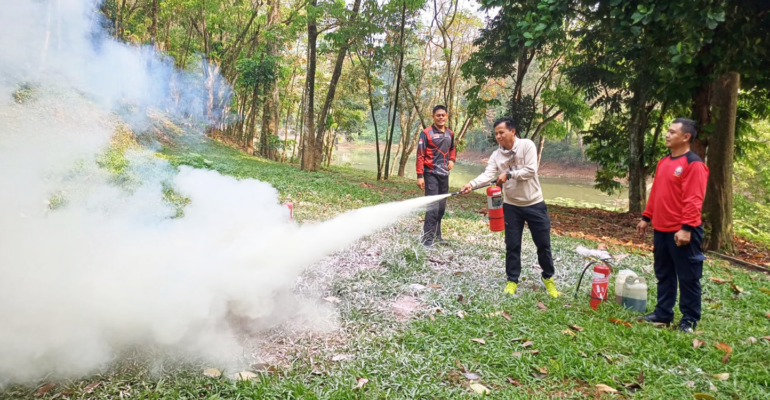IPB University Graduate School Education Workers Follow Fire Fighting Training

Postgraduate School (SPs) IPB University held a Fire Fighting Training (24/8) at IPB Dramaga Campus, Bogor. This training was attended by all educational staff (tendik) in SPs IPB University.
Rudi Irawan, SP, MSi, Chairman of Administration of SPs IPB University, expressed his gratitude to the representative of the Bogor City Fire and Rescue Service, Jaya, who was present and provided material related to the procedures for anticipating and handling in the event of a fire at work or at home.
“This training is a very good forum to be able to gather with the education workers in SPs. It is hoped that this training can increase our knowledge and courage in the event of a fire and of course be carried out properly in accordance with existing operational standards,” he said.
Rudi added that this training aims to provide an understanding of the causes of fire, the basics of fire prevention efforts, and training in operating a light fire extinguisher (APAR).
“Hopefully, the tendik friends can practice the use of APAR properly. Although this is the umpteenth training, there are some tendik friends who have never participated so that they can provide experience,” he added.
Meanwhile, Jaya as a training speaker from the Bogor City Fire and Rescue Service explained several types of fire extinguishers used, namely Dry Powder extinguishers and CO2 extinguishers.
APAR Dry Powder is a versatile fire extinguisher because it is effective for extinguishing fires in almost all classes of fires such as class A, B, and C. However, it has many disadvantages, such as dirt and others.
“Meanwhile, CO2 fire extinguishers are suitable for use in rooms, such as offices and laboratories and other rooms. However, the characteristics of this CO2 APAR can make people faint or die if they lack oxygen,” he explained.
Another weakness, Jaya continued, is that CO2 fire extinguishers cannot prevent fires from reoccurring after the fire is extinguished. This is because CO2 cannot bind O2 continuously. Therefore, according to him, the use of APAR Dry Powder and APAR CO2 must be in accordance with usage.
“The failure of this APAR, there are several factors ranging from the type and size are not appropriate, the tool is not functioning, misplaced, and the officer factor. This officer can be caused by not being appointed or not skilled in using APAR,” he explained.
In addition, he added, the distance between the placement of fire extinguishers from one another is 15 meters or determined by an expert supervisor. Therefore, if there is a fire extinguisher jam, officers can look for fire extinguishers in other rooms, so that the impact of the fire can be resolved immediately. (HBL/Rz) (IAAS/ZQA)



